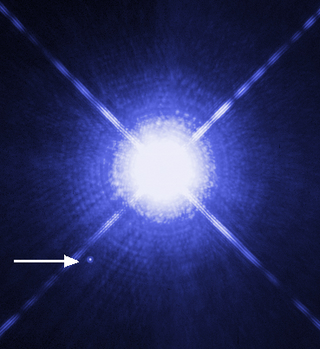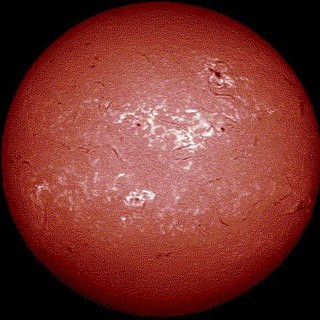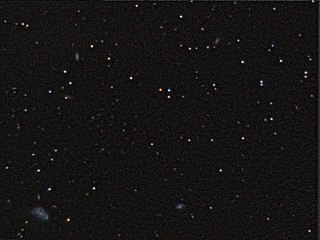Related Research Articles

A corona is the outermost layer of a star's atmosphere. It consists of plasma.

A white dwarf is a stellar core remnant composed mostly of electron-degenerate matter. A white dwarf is very dense: its mass is comparable to the Sun's, while its volume is comparable to the Earth's. A white dwarf's faint luminosity comes from the emission of residual thermal energy; no fusion takes place in a white dwarf. The nearest known white dwarf is Sirius B, at 8.6 light years, the smaller component of the Sirius binary star. There are currently thought to be eight white dwarfs among the hundred star systems nearest the Sun. The unusual faintness of white dwarfs was first recognized in 1910. The name white dwarf was coined by Willem Luyten in 1922.

X-ray astronomy is an observational branch of astronomy which deals with the study of X-ray observation and detection from astronomical objects. X-radiation is absorbed by the Earth's atmosphere, so instruments to detect X-rays must be taken to high altitude by balloons, sounding rockets, and satellites. X-ray astronomy uses a type of space telescope that can see x-ray radiation which standard optical telescopes, such as the Mauna Kea Observatories, cannot.

Brown dwarfs are substellar objects that are not massive enough to sustain nuclear fusion of ordinary hydrogen (1H) into helium in their cores, unlike a main-sequence star. Instead, they have a mass between the most massive gas giant planets and the least massive stars, approximately 13 to 80 times that of Jupiter (MJ). However, they can fuse deuterium (2H) and the most massive ones can fuse lithium (7Li).

A chromosphere is the second layer of a star's atmosphere, located above the photosphere and below the solar transition region and corona. The term usually refers to the Sun's chromosphere, but not exclusively.

Wolf 359 is a red dwarf star located in the constellation Leo, near the ecliptic. At a distance of approximately 7.9 light years from Earth, it has an apparent magnitude of 13.54 and can only be seen with a large telescope. Wolf 359 is one of the nearest stars to the Sun; only the Alpha Centauri system, Barnard's Star, and the brown dwarfs Luhman 16 and WISE 0855−0714 are known to be closer. Its proximity to Earth has led to its mention in several works of fiction.

An exomoon or extrasolar moon is a natural satellite that orbits an exoplanet or other non-stellar extrasolar body.

An RS Canum Venaticorum variable is a type of variable star. The variable type consists of close binary stars having active chromospheres which can cause large stellar spots. These spots are believed to cause variations in their observed luminosity. Systems can exhibit variations on timescales of years due to variation in the spot surface coverage fraction, as well as periodic variations which are, in general, close to the orbital period of the binary system. Some systems exhibit variations in luminosity due to their being eclipsing binaries. Typical brightness fluctuation is around 0.2 magnitudes. They take their name from the star RS Canum Venaticorum.
Z Andromedae is a binary star system consisting of a red giant and a white dwarf. It is the prototype of a type of cataclysmic variable star known as symbiotic variable stars or simply Z Andromedae variables. The brightness of those stars vary over time, showing a quiescent, more stable phase and then an active one with a more pronounced variability and stronger brightening and/or dimming.
GRW +70 8247 is a white dwarf star located 42 light-years from Earth in the constellation Draco. With a magnitude of about 13 it is visible only through a large telescope.
An AM Canum Venaticorum star, is a rare type of cataclysmic variable star named after their type star, AM Canum Venaticorum. In these hot blue binary variables, a white dwarf accretes hydrogen-poor matter from a compact companion star.
HIP 70849 is a star with two non-stellar companions in the southern constellation Lupus. It is a 10th magnitude star, making it too faint to be visible to the naked eye. The system is located at a distance of 78.7 light-years from the Sun based on parallax measurements.
HD 81817 is a possible binary star system with two brown dwarf companions in the northern circumpolar constellation of Draco. It has an orange hue and is visible to the naked eye with an apparent visual magnitude of 4.28. The system is located at a distance of approximately 990 light years from the Sun based on parallax, and is drifting closer with a radial velocity of −7 km/s. It is a member of the IC 2391 moving group.

CE Gruis is a faint binary star system in the constellation Grus. It is a variable star, with a B-band brightness that ranges from a peak magnitude of 17.4 down to a minimum of 19.5 over a period of 108.6 minutes. The system is composed of a white dwarf and donor star, locked into a close, synchronous orbit. In such systems, known as polars, material from the donor star does not form an accretion disc around the white dwarf because of its intense magnetic field, but rather streams directly onto it along columns.
SW Sextantis variable stars are a kind of cataclysmic variable star; they are double-star systems in which there is mass transfer from a red dwarf to a white dwarf forming a stable accretion disc around the latter. Unlike other non-magnetic cataclysmic variables, the emission lines from hydrogen and helium are not doubled, except briefly near phase 0.5.

V392 Persei, also known as Nova Persei 2018, is a bright nova in the constellation Perseus discovered on April 29, 2018. It was previously known as a dwarf nova.

WD 0145+234 is a white dwarf star approximately 95 ly (29 pc) from Earth in the constellation of Aries that has been associated with studies suggesting that a very large exoasteroid near the star was substantially disrupted, resulting in a considerable amount of dust and debris around the star. Alternatively the outburst around WD 0145+234 is explained with ongoing collisions between planetesimals inside the dusty debris disk around the white dwarf.

WD J0914+1914 is the first single white dwarf star found to have a giant planet orbiting it. Evidence of the giant planet was discovered by a team of astronomers from the UK, Chile and Germany.

UZ Fornacis is a binary star in the constellation of Fornax. It appears exceedingly faint with a maximum apparent magnitude 17.0. Its distance, as measured by Gaia using the parallax method, is about 780 light-years.

BG Canis Minoris is a binary star system in the equatorial constellation of Canis Minor, abbreviated BG CMi. With an apparent visual magnitude that fluctuates around 14.5, it is much too faint to be visible to the naked eye. Parallax measurements provide a distance estimate of approximately 2,910 light years from the Sun.
References
- 1 2 3 4 5 6 7 8 9 10 11 12 13 14 "SIMBAD Query Result: GD 356". SIMBAD. Centre de Données astronomiques de Strasbourg . Retrieved 13 June 2012.
- 1 2 "ARI Data Base for Nearby Stars". ARICNS. Centre of Astronomy, Heidelberg University.
- 1 2 Muir, Hazel (1 August 1998). "The Earth could be in for an electrifying time". New Scientist (2145): 7.
- 1 2 3 4 5 6 7 8 9 10 Wickramasinghe, Dayal T.; Farihi, Jay; Tout, Christopher A.; Ferrario, Lilia; Stancliffe, Richard J. (9 February 2010). "Does GD356 have a Terrestrial Planetary Companion?". Monthly Notices of the Royal Astronomical Society . 404 (4): 1984–1991. arXiv: 1002.1761 . Bibcode:2010MNRAS.404.1984W. doi:10.1111/j.1365-2966.2010.16417.x. S2CID 119255099.
- 1 2 3 Ferrario, Lilia; Wickramasinghe, Dayal T.; Liebert, James; Schmidt, Gary D.; Bieging, John H. (1997). "The Magnetic Field and Emission-Line Spectrum of the Remarkable White Dwarf GD 356". Monthly Notices of the Royal Astronomical Society. 289 (1): 105–116. Bibcode:1997MNRAS.289..105F. doi: 10.1093/mnras/289.1.105 .
- ↑ Brinkworth, C. S.; M. R. Burleigh; G. A. Wynn; T. R. Marsh (2004). "Photometric variability of the unique magnetic white dwarf GD 356". Monthly Notices of the Royal Astronomical Society. 384 (3): L33–L37. arXiv: astro-ph/0312311 . Bibcode:2004MNRAS.348L..33B. doi:10.1111/j.1365-2966.2004.07538.x. S2CID 15677179.
- 1 2 3 4 5 Greenstein, Jesse L.; James K. McCarthy (15 February 1985). "Emission lines in the magnetic white dwarf GD 356". Astrophysical Journal, Part 1. 289: 732–747. Bibcode:1985ApJ...289..732G. doi:10.1086/162937. ISSN 0004-637X.